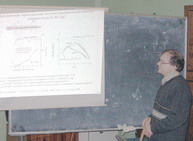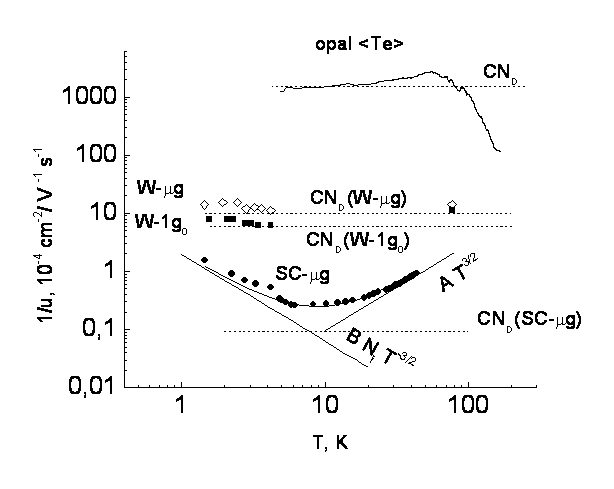|
|
|
|
|
|
||
|
|
|
|
|
|
||
|
|
|
 Sergey Yakimov, Junior Researcher |
Crystal structure of tellurium

Parameters of tellurium crystal structure





![]()

![]()
![]()
![]()

![]()
Tellurium crystal solidified in microgravity SC-mg
![]()


X - mobility for the Czhochralski Te crystal.











Tellurium cluster lattice in opal with a replica of the octa- and tetrahedral voids as viewed with an electron microscope. Opal crystal filled by Te from a melt under high gas pressure P~3 kBar. Regularly distributed black spots a cluster lattice in the opal matrix (white spots - amorphous silica SiO2 spheres with diameter d~200 ¸ 250 nm).

Temperature dependencies of electrical resistivity r for W-mg (1), W-1g0 (2) and Opal<Te> (3) samples. 1*, 2* the data of measurements in the helium temperature range using platinum contacts fused into a sample. 3* - the repeated measurements.
1)
r (mg)>r
(1g0)
and r(Opal<Te>)
in the low temperature range.
2) High temperature
parts of the curves correspond to the transition to the intrinsic
conductivity (Energy gap in Te Eg(0)=0.334 eV).
3) The resistivity at
helium temperatures is determined by the electrically active and
neutral impurities and grain boundaries.
The resulting inverse mobility for the SC-mg
sample can be represented by the Matthiessen's rule:

The values of
parameters in Eq. 1 for various Te samples.


Temperature dependencies of the Hall coefficient for the monocrystalline SC-mg sample and W-mg microstructure sample, remelted at microgravity conditions, compared with the parameters for W-1g0 opal<Te> samples, made at the earth conditions. (R at 300 K has the negative sign).

Temperature dependencies of the reversal hole mobility for the monocrystalline SC-mg sample and W-mg microstructure sample, remelted at microgravity conditions, compared with the parameters of the W-1g0 and opal<Te> samples, made at the earth conditions. Points are for the experimental data, curves are for calculation using the Eq.1 with parameters, showed in Table 1. Straight lines - contributions of scattering mechanisms for the SC-mg sample. Dashed lines – main contributions of the CND term to the minima of 1/u value.
Determination of the
defect concentration ND.

Modulation of the mobility at 77 K and defect concentration ND along the W-mg and W-1g samples, calculated using above equations. For comparison the electrical resistivity profile, r300K(q) along the W-mg sample is shown.

The behavior of the magnetoresistance for the single crystal SC-mg , microstructure samples W- Te and Opal<Te> samples at low temperatures.
Conclusions